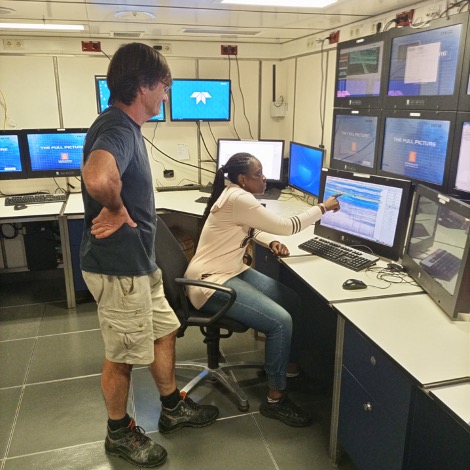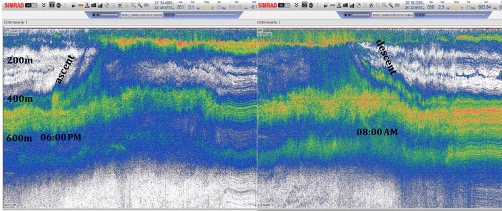(deutsche Version unten)
Today, I have the opportunity to share on this blog my stay on board of the RV SONNE in which I embarked since the 10/12/2021, since one month after having left two days ago my beautiful and warm country, Senegal. Yes, I spent Christmas and New Year’s Eve at sea, an experience that I am pleased to share because it was a lot of fun. Birgit, the campaign coordinator, did everything to brighten up the holidays (Chrimas party, Cinema, Karaoke song, New year party).
This cruise is an opportunity to finally discover the German ship SONNE that I had already heard about and that I wanted to discover so much. It is also for me the opportunity to renew with the sea expeditions, the last one dating back to 2020 with Norwegian and Moroccan ships in the North, Central and South Atlantic when I was still a PhD Student.
This is my first experience in the Caribbean and the Pacific, but also as a young researcher I have the responsibility to take care of the acoustic acquisitions. Yes, I said acoustics, I don’t mean music but sound in water.
Active acoustics is a rather old approach, more than 100 years old. During the First World War, Paul Langevin, a French physicist, assisted by the engineer Constantin Chilowski, were the first to create a sonar in 1915. Using Sonar, it was possible to identify objects in the water column such as submarines and mines in the early days. Later this technique was used in other fields such as fishing, marine geosciences, exploitation of offshore petroleum resources etc.
Nowadays, with the evolution of acoustic tools, the acoustic study of plankton is now within the reach of scientists. Macrozooplankton and micronectonic organisms aggregate at specific depths and appear as sound scattering layers (SSL) on the echogram of echosounder, as can be seen int he image at the top of this blog post. These organisms are the first two animal levels in the marine food web. This intermediate compartment plays a major role in the ecological health of the ecosystem and top predators by supporting the diet of a wide variety of large fish, birds and marine mammals.
Acoustics is a valuable tool for an ecosystemic approach of aquatic environments, especially in the pelagic domain which contains important resources. As in all marine ecosystems, a real phenomenon occurs twice a day in the eastern North Atlantic, the diel vertical migration (DVM). The majority of macrozooplankton and micronecton organisms travel vertically tens or even hundreds of meters, migrating from deep areas where they reside during the day to surface waters where they spend the night, ensuring the exchange of energy and matter between water masses. Most commonly, plankton migrate to surface waters at dusk and return to deeper waters at dawn. This vertical migratory behavior is explained as an escape from visual predation during the day, as the organisms feed on the surface at night. This active transport of organisms on the vertical and the associated metabolic activity (surface feeding at night and deep metabolization during the day) has significant consequences on the carbon cycle.
Ms. Ndague DIOGOUL (PhD), IRD, ISRA/CRODT, UMR 195 LEMAR, Dakar, Senegal

SO287-CONNECT: Ökosystemische akustische Beobachtung
Heute habe ich die Gelegenheit, in diesem Blog von meinem Aufenthalt an Bord der RV SONNE zu berichten, die ich am 10.12.2021, also einen Monat nach meiner Abreise aus dem schönen und warmen Senegal betreten habe. Ja, ich habe Weihnachten und Silvester auf See verbracht, eine Erfahrung, die ich gerne teile, denn es hat mir viel Spaß gemacht. Birgit, die Koordinatorin der Kampagne, hat alles getan, um die Feiertage zu verschönern (Weihnachtsfeier, Kino, Karaoke-Song, Silvesterparty).
Diese Expedition ist eine Gelegenheit, endlich das deutsche Forschungschiff SONNE kennen zu lernen, von dem ich schon gehört hatte und das ich schon so lange entdecken wollte. Es ist für mich auch die Gelegenheit, meine Erfahrungen auf See zu erneuern – die letzte fand 2020 mit norwegischen und marokkanischen Schiffen im Nord-, Mittel- und Südatlantik statt, als ich noch Doktorandin war. Dies ist meine erste Erfahrung in der Karibik und im Pazifik, aber auch als junge Forscherin habe ich die Verantwortung, mich um die akustischen Signale zu kümmern. Ja, ich sagte Akustik, aber ich meine nicht Musik, sondern Klang im Wasser.
Die aktive Akustik ist ein ziemlich alter Ansatz, mehr als 100 Jahre alt. Während des Ersten Weltkriegs entwickelte Paul Langevin, ein französischer Physiker, mit Unterstützung des Ingenieurs Constantin Chilowski 1915 als Erster ein Sonargerät. Mit Hilfe des Sonars war es damals möglich, Objekte in der Wassersäule wie U-Boote und Minen zu identifizieren. Später wurde diese Technik auch in anderen Bereichen eingesetzt, zum Beispiel in der Fischerei, den Meeresgeowissenschaften, der Erschließung von Offshore-Erdölvorkommen und so weiter.
Heutzutage, mit der Entwicklung akustischer Instrumente, kann die Wissenschaft auch Plankton mit aktustischen Methoden untersuchen. Makrozooplankton und mikronektonische Organismen sammeln sich in bestimmten Tiefen und erscheinen als schallstreuende Schichten (sound scattering layers, SSL) auf dem Echogramm eines Echolots – wie zu sehen im Bild ganz oben in diesem Beitrag. Diese Organismen bilden die ersten beiden tierischen Ebenen im marinen Nahrungsnetz. Dieser Zwischenbereich spielt eine wichtige Rolle für die ökologische Gesundheit des Ökosystems und wichtiger Räuber, da er die Nahrung für eine Vielzahl von großen Fischen, Vögeln und Meeressäugern darstellt.
Die Akustik ist ein wertvolles Instrument für einen ökosystemischen Ansatz in der aquatischen Umwelt, insbesondere im pelagischen Bereich, der wichtige Ressourcen enthält. Wie in allen marinen Ökosystemen tritt im östlichen Nordatlantik zweimal täglich das Phänomen der vertikale Tageswanderung auf (diel vertical migration, DVM). Die meisten Makrozooplankton- und Mikronekton-Organismen wandern vertikal Dutzende oder sogar Hunderte von Metern von tiefen Gebieten, in denen sie sich tagsüber aufhalten, in die Oberflächengewässer, wo sie die Nacht verbringen, und sorgen so für den Austausch von Energie und Stoffen zwischen den Wassermassen. Meistens wandert das Plankton in der Abenddämmerung in die Oberflächengewässer und kehrt in der Morgendämmerung in tiefere Gewässer zurück. Dieses vertikale Wanderverhalten wird damit erklärt, dass die Organismen nachts an der Oberfläche fressen, während sie tagsüber der visuellen Prädation entgehen. Dieser aktive Transport von Organismen in der Vertikalen und die damit verbundene Stoffwechselaktivität (Fütterung an der Oberfläche in der Nacht und Stoffwechsel in der Tiefe am Tag) hat erhebliche Auswirkungen auf den Kohlenstoffkreislauf.
Ndague DIOGOUL (PhD), IRD, ISRA/CRODT, UMR 195 LEMAR, Dakar, Senegal
